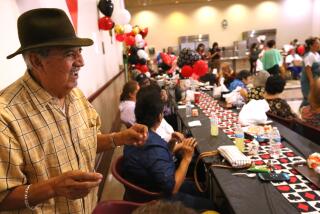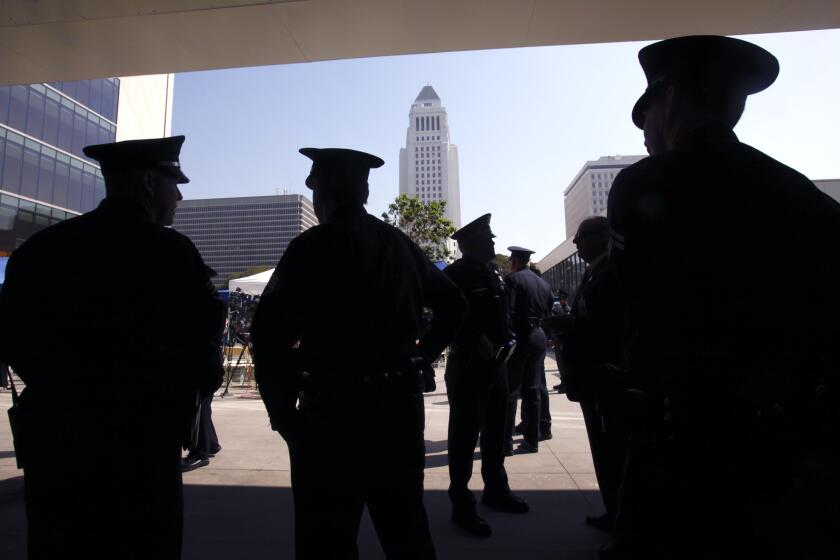Future for Los Angeles’ middle class is uncertain
You may remember the ruckus that arose a couple of years ago when a local Spanish-language television station, Channel 62, put up a billboard publicizing its newscasts. Next to the words “Los Angeles,” the abbreviation “CA” was crossed out and “Mexico” written in its stead.
Many reacted angrily, saying the sign was glorifying illegal immigration. Others accused the complainers of being racist xenophobes and maintained that the ad was simply celebrating the region’s Latino flavor.
Whatever you thought of the promotion, I’m here to tell you: We are, in at least one sense, perilously close to becoming Los Angeles, Mexico.
I am referring specifically to an L.A. area that finds itself deeply divided along class lines, with 250,000 millionaires, 1.6 million poor people (with annual incomes of about $30,000 for a family of four) and those in the middle facing a miserable squeeze.
Once the paragon of the American dream, Los Angeles in the last 25 years has become a place where the level of income inequality doesn’t look too much different from what’s found south of the border or in any number of developing nations.
And unless we make real strides in improving basic education and worker training -- and do it fast -- we’re in danger of seeing the middle class hollowed out to a devastating degree.
In recent weeks, a gaggle of politicians, policymakers and civic leaders has begun to speak out on this issue -- one that, more than any other perhaps, goes to the heart of what kind of society we hope to live in.
The Southern California Assn. of Governments last month held a symposium with the dispiriting title “The Middle Class on Life Support.” At the same time, the United Way of Greater Los Angeles warned that the metropolis “in many ways remains ‘A Tale of Two Cities’ ” -- one that stands as “the entertainment and international trade capital of the nation” but where “the vast majority of workers toil in low-wage jobs that do not provide for basic living costs.”
UCLA economists then took up the charge last week, convening a conference that examined, among other alarming questions, “Can there be a middle class without manufacturing?”
Not every indicator, thankfully, is running in the wrong direction. UCLA’s Jerry Nickelsburg has found that in the last five years -- with the aerospace industry’s shakeout of the 1990s finally behind us -- the gap between rich and poor in L.A. has actually eased somewhat.
In a report that has generated a fair bit of attention in the last several days, Nickelsburg used a measure known as the Gini Index (named for Corrado Gini, an Italian statistician and sociologist), in which zero signals perfectly even income distribution across the community and 100 represents the most extreme concentration of wealth.
L.A. had a mark of 53.57 in 1989, but that soared to 66.73 a decade later. By 2005, the figure had fallen back to 61.57 -- a change that Nickelsburg attributes to the creation of thousands of relatively well-paying service-sector jobs: paralegals, graphic designers, audiovisual equipment technicians and more.
Even with that, Nickelsburg points out, Los Angeles is bound to have a wider disparity of income than the U.S. as a whole. (The nation’s Gini score, based on different data, is 40.8.)
After all, an urban area with so many cultural amenities and fantastic weather will always be a lure for the rich. And the city’s proximity to Latin America and the Pacific Rim will continue to make it a magnet for immigrants, many of whom arrive here poor.
Both of these, Nickelsburg says, are things that “we should celebrate, not be afraid of per se.” He’s right about that.
And yet, the truth is, I can’t find much cause for cheer. As encouraging as his research is, it doesn’t mitigate the harsh reality that so many here must grapple with:
* The typical worker in L.A. County earned 6.4% less in 2005 ($15 an hour) than he or she did in 1979 ($16.03), when adjusted for inflation, the California Budget Project found in an analysis issued last fall. Elsewhere in California, real wages went up 5.9% during that span.
* L.A. is the least affordable housing market in the country, with just 2% of homes sold in the fourth quarter of 2006 considered within reach for those earning the area’s median family income ($56,200), according to a ranking by the National Assn. of Home Builders and Wells Fargo & Co.
* Nearly 30% of adults in L.A. County lacked medical insurance for all or part of the year in 2005, the UCLA Center for Health Policy Research reported this month. That compared with less than 25% for California.
As Bill Pitkin, the United Way of Greater Los Angeles’ research director, wrote in The Times on Sunday: “Overall income distribution is just one measure of inequality and does not provide a complete picture of the social and economic divisions that plague Los Angeles.”
There is no single reason that the middle class is falling ever more behind. Those who’ve studied the matter point to a whole bunch of factors, including globalization; the transition from a manufacturing to a service economy; top corporate executives raking in obscene amounts of income at the expense of the rank and file; and the decline of unions.
Yet many agree that, especially locally, we need to concentrate on one particular fix: making sure that our current and future workers have the skills they need to adapt to a fast-moving, often technologically demanding job market.
“We’re not going to succeed in building the middle class,” Mayor Antonio Villaraigosa told those gathered at UCLA last week, “if we don’t change the paradigm of failure in our public schools.”
The mayor was fired up, and it was heartening to hear so many smart people offering ways to cure our city’s ills. (You can -- and should -- weigh in with your own proposed solutions at www.uclaforecast.com/solutions.)
Some believe that we’re making progress. When it comes to turning around public education, “we’re much further along than we were five years ago,” says Russell Goldsmith, chairman of City National Bank and the head of a committee on jobs and the economy that the mayor formed last year. He cites the rise of charter schools around L.A. and Villaraigosa’s focus on education as big positives.
I’m less sure. All the talk is great; the forums are stimulating. But I’m worried that we’re running out of time to act.
“While we have stepped away from the income inequality levels of Mexico and other developing countries,” Nickelsburg notes, “we are not very far away.”
If we continue down our current path too much longer -- with 4 out of every 10 ninth-graders in the county unlikely to graduate from high school -- never mind being labeled Los Angeles, Mexico.
Try Los Angeles, Honduras. Or Los Angeles, Nepal. Or Los Angeles, Zimbabwe.
You’ll be able to take your pick.
Rick Wartzman is an Irvine senior fellow at the New America Foundation. He is reachable at rick.wartzman@latimes.com.
More to Read
Sign up for Essential California
The most important California stories and recommendations in your inbox every morning.
You may occasionally receive promotional content from the Los Angeles Times.










